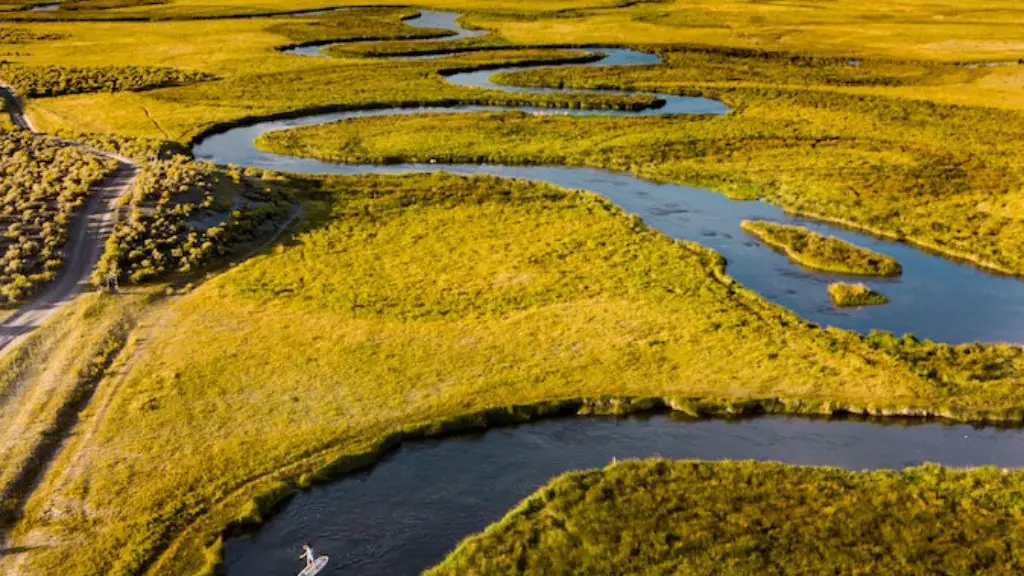General Overview and Description
The Nile is a massive river that runs through East Africa and provides the foundation for life in some of the most populous countries in the world. It is one of the oldest major rivers in the world, as well as the world’s longest. The Nile stretches over 4,258 miles, beginning in Burundi in the region known as Lake Victoria and ending in Egypt’s Mediterranean coast. Along its course, it flows through 9 countries—Burundi, Rwanda, Uganda, Democratic Republic of Congo, Tanzania, Kenya, Ethiopia, South Sudan, and Egypt.
The river acts as a natural resource, providing moisture to arid desert regions. It also provides a source of water for drinking, agricultural purposes, and transportation. Additionally, the Nile is home to a variety of rare and endangered species, and is an excellent location for fishing.
The Nile Basin is one of the most water-stressed regions of the world, yet it is home to over 350 million people. As a result, people in the region depend on the Nile for their livelihood as well as their personal needs. Because of this, the Nile provides multiple economic benefits to the communities it services.
Economic and Cultural Significance of the Nile
The Nile Basin is an important economic, political, and cultural resource to the countries that rely upon it. For example, Egypt makes up the majority of the Nile’s riparian population and has used the river for its sustenance for thousands of years. Agriculture is an important part of Egypt’s economy and much of it is beholden to the flow of the river.
The land that lines the banks of the Nile is also incredibly fertile and has some of the most productive agricultural soil in the world. This can be seen in the sheer number of crops grown in the region, including wheat, maize, millet, cotton, and dates. In fact, the Nileas has long been the source of life and sustenance and is a crucial part of the nation’s national identity.
The Nile is also a major transportation route with boats travelling up and down its waters. This improves the economic capabilities of the countries that line its course by providing an easy way to move goods and people across the continent while also increasing the cultural ties of its inhabitants. Additionally, the Nile serves as a source of electricity and power with hydroelectric dams providing much-needed energy to the countries it flows through.
The river has also played a major role in the history of Africa, spanning 4,000 years. The Nile has been featured in paintings, songs, and art, and is often used as the centerpiece of literature and mythology. Its importance to life in the region has been recognized for centuries, with many civilizations rising and falling along the banks of the river.
Environmental Impact
The Nile is home to a vast array of species, both terrestrial and aquatic. It is one of the last remaining habitats for a number of endangered species, including the African elephant, the hippopotamus, and the Nile crocodile. Furthermore, the Nile is home to several species of fish, amphibians, reptiles, and birds.
Unfortunately, the river is also under-threat due to human activities such as farming, urbanization, and overfishing. As the population in the region grows, demand for water also increases, resulting in over-extraction from the river. This is pushing many species to the brink of extinction and damaging the delicate ecosystem of the river.
In addition, the damming of the river for irrigation and electricity production has a detrimental effect on the environment. The dams create reservoirs, which disrupt natural river flow and can cause large-scale flooding in the region when mismanaged. Furthermore, the reservoirs cause water levels to drop and make it difficult for local wildlife to find food and reproduce.
As such, it is essential that the countries affected by the Nile take steps to protect it. This can include regulating water usage to ensure that the environment is not over-exploited, as well as strengthening environmental laws and regulations concerning the river.
Benefits of the Nile
The Nile produces a number of benefits for the people living along its course. It is the backbone of life in the region, providing critical resources for local populations, as well as a means of transport and communication. Furthermore, the fertile soil and temperate climate make it an ideal place for growing crops and providing food for the population.
In addition to its practical uses, the Nile also offers a cultural and spiritual connection to the people of the region. For many people, the river has been a source of solace and inspiration, and its importance to life in the region cannot be overstated.
The Nile is also a source of power, with its hydroelectric dams providing electricity to the region. This helps to power homes and businesses, and can help to boost the economic development of the countries that depend upon it.
Ultimately, the Nile serves an important role in providing sustenance, security, and peace of mind to the peoples of the region. As such, it is essential that the countries affected by the Nile work together to ensure that it is protected and preserved.
Future of the Nile
With the growing population in the region and increasing demand for water, the future of the Nile is uncertain. If steps are not taken to properly manage the river, the delicate balance of its ecosystem could be destroyed. This could have devastating effects not just on the wildlife, but also on the people that depend upon it for their livelihood.
Fortunately, there are strategies that can be implemented to ensure that the future of the Nile is a positive one. For example, the countries in the region can ensure that they use water wisely and conserve the resources of the river. They can also promote sustainable agricultural practices and ensure that their activities are not detrimental to the environment.
Additionally, the countries of the region should work together to protect the river and promote collaboration over exploitation. By doing so, the people of the region can ensure that the Nile will be a thriving and vibrant resource for future generations.
Pollution and Issues
In recent years, pollution has become a major issue for the Nile. Agricultural runoff and improper sewage disposal are two of the major factors causing pollution in the river. As a result, the water quality has decreased significantly and it has become a major threat to the health of the people in the region.
In order to combat this problem, stricter regulations should be put in place to ensure that agricultural and industrial waste are not being improperly disposed of in the river. Additionally, wastewater treatment systems should be improved and enforced to reduce the amount of pollutants entering the river.
Another major issue facing the Nile is climate change. As the world warms, the river’s ice-cap is melting, which is causing an increase in river flow and water levels. This causes major flooding in areas downstream and can result in significant destruction and loss of life.
To protect the population from the effects of climate change, the countries along the river’s path must take proactive steps to reduce emissions, protect existing wetlands and freshwater sources, and promote sustainable development. This will help to reduce the impact of climate change on the region, and ensure that the Nile river remains a source of life and prosperity for future generations.





